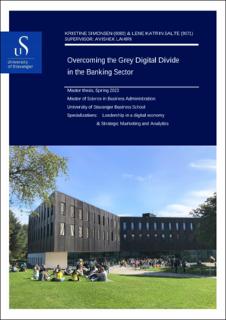| dc.description.abstract | The thesis highlights the high degree of non-digital seniors in Norway and the different customer touchpoints they might be excluded from because the provider only distributes digital solutions. The research shows the necessity of being digital today and that seniors tend to be less likely to utilize digital solutions, e.g., those distributed by the bank. Non-digital seniors face exclusion and economic disadvantages from both the banking sector, but also various other services.
The problem statement for this thesis is “How can the banking industry take measures to overcome the grey digital divide that is occurring due to digital transformation?”.
The research questions which will be used to guide the thesis are:
1. Are seniors (65+ years of age) being excluded from banks digital transformation?
2. What are the variables influencing seniors’ adoption of the mobile banking application?
3. What measures can banks take to include older customers more and get them to adopt the mobile banking application?
The data were collected in Norway. Inspired by the Unified Theory of Acceptance and Use of Technology (UTAUT), it was discovered which variables influence behavioral intention and actual usage related to mobile banking applications. The scales were adapted, and social influence was divided into two, one from friends and one from family. Performance expectancy was also adapted and divided into two items, ‘useful’ and ‘efficient’. It was discovered that when age is used as a moderator, performance expectancy, facilitating conditions, and social influence from family have a significant positive effect on behavioral intention.
The number of seniors over 70 in Norway is expected to double by 2060, further emphasizing the need to prioritize seniors. This means that even though the bank has a lot of younger customers, they should not disregard seniors' purchasing power and unique needs. To include seniors, the banks should offer various learning options tailored to seniors and their preferred way of learning. The recommendations include providing a step-by-step instruction sheet available for download, online how-to videos, and individual training sessions with a tutor. This ensures that seniors can access the necessary support and resources to understand and adopt the mobile banking application. | |
